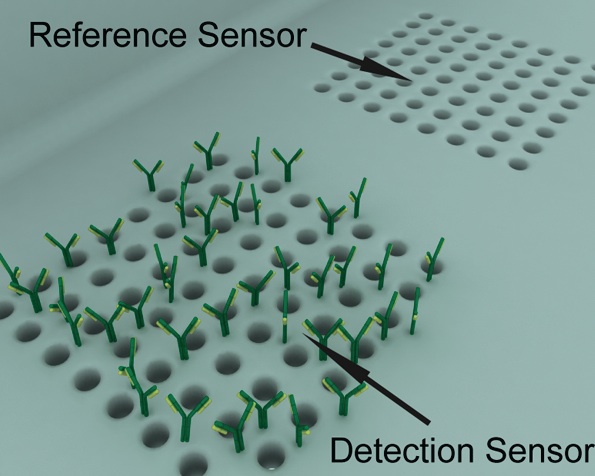 aide
aide
Accueil > Accueil > Présentation
NanoBioSensor
This project aims to develop nanoplasmonic biosensor based on new approach, namely nonlinear optical (NLO) signal generation on original nanostructures. Recently we demonstrated second- and third-harmonic generations on single nanostructures as an alternative to fluorescence emission in optical microscopy and to surface plasmon resonance (SPR) techniques towards in vitro studies of bio-molecular interactions. We have in particular identified and studied in-depth the extremely strong quadratic (SHG) and cubic (THG) optically nonlinear emissions from plasmon based metallic nano-apertures with up to 105 counts/s, which motivate us to predictively engineer and apply tailored nanostructures towards nonlinear optical microscopy for bio molecular imaging. As described earlier, the NLO signal generation directly linked with surface plasmon is very sensitive to refraction index modification. The effect of NLO generation on nanostructures is recent and very promising for improving the sensitivity of existing plasmonic biosensor. Thus, the LPQM team own strong expertise in nanostructure fabrication and the NLO signal characterization. The LBPA team is expert in surface functionalization of gold and silver surfaces of the nanostructures and profound knowledge of DNA-protein kinetic of interaction. Combing the knowledge and expertise of both teams will surely lead to developing an exptremelly competitive biosensor: the NLO nanoplasmonic biosensor.

In terms of fundamental scientific contribution, this project will result in the development of a new generation of nano-biosensors, based on the interaction of light with biopolymer-metal interfaces. We expect that this research program will improve our understanding on the related basic phenomena, including metal-dielectric interface nonlinearities, the role of nonlinearities in establishing the limits of light focusing and light amplification by nanometals etc.
We believe that the result of this work will lead to a new nanophotonic device for biosensing.
©LPQM-V.Shynkar, Cachan
In terms of fundamental scientific contribution, this project will result in the development of a new generation of nano-biosensors, based on the interaction of light with biopolymer-metal interfaces. We expect that this research program will improve our understanding on the related basic phenomena, including metal-dielectric interface nonlinearities, the role of nonlinearities in establishing the limits of light focusing and light amplification by nanometals etc.
We believe that the result of this work will lead to a new nanophotonic device for biosensing.
